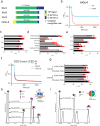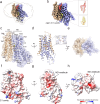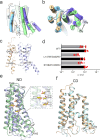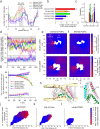Structure and function of the human apoptotic scramblase Xkr4
- PMID: 40781244
- PMCID: PMC12334663
- DOI: 10.1038/s41467-025-62739-1
Structure and function of the human apoptotic scramblase Xkr4
Abstract
Phosphatidylserine externalization on the surface of dying cells is a key signal for their recognition and clearance by macrophages and is mediated by members of the X-Kell related (Xkr) protein family. Defective Xkr-mediated scrambling impairs clearance, leading to inflammation. It was proposed that activation of the Xkr4 apoptotic scramblase requires caspase cleavage, followed by dimerization and ligand binding. Here, using a combination of biochemical approaches we show that purified monomeric, full-length human Xkr4 (hXkr4) scrambles lipids. CryoEM imaging shows that hXkr4 adopts a novel conformation, where three conserved acidic residues create a negative electrostatic surface embedded in the membrane. Molecular dynamics simulations show this conformation induces membrane thinning, which could promote scrambling. Thinning is ablated or reduced in conditions where scrambling is abolished or reduced. Our work provides insights into the molecular mechanisms of hXkr4 scrambling and suggests the ability to thin membranes might be a general property of active scramblases.
© 2025. The Author(s).
Conflict of interest statement
Competing interests: The authors declare no competing interests.
Figures





Update of
-
Structure and function of the human apoptotic scramblase Xkr4.bioRxiv [Preprint]. 2024 Aug 9:2024.08.07.607004. doi: 10.1101/2024.08.07.607004. bioRxiv. 2024. Update in: Nat Commun. 2025 Aug 8;16(1):7317. doi: 10.1038/s41467-025-62739-1. PMID: 39149361 Free PMC article. Updated. Preprint.
Similar articles
-
Structure and function of the human apoptotic scramblase Xkr4.bioRxiv [Preprint]. 2024 Aug 9:2024.08.07.607004. doi: 10.1101/2024.08.07.607004. bioRxiv. 2024. Update in: Nat Commun. 2025 Aug 8;16(1):7317. doi: 10.1038/s41467-025-62739-1. PMID: 39149361 Free PMC article. Updated. Preprint.
-
Simulation-based survey of TMEM16 family reveals that robust lipid scrambling requires an open groove.Elife. 2025 Aug 6;14:RP105111. doi: 10.7554/eLife.105111. Elife. 2025. PMID: 40768244 Free PMC article.
-
Adapting Safety Plans for Autistic Adults with Involvement from the Autism Community.Autism Adulthood. 2025 May 28;7(3):293-302. doi: 10.1089/aut.2023.0124. eCollection 2025 Jun. Autism Adulthood. 2025. PMID: 40539213
-
In or out of the groove? Mechanisms of lipid scrambling by TMEM16 proteins.Cell Calcium. 2024 Jul;121:102896. doi: 10.1016/j.ceca.2024.102896. Epub 2024 May 9. Cell Calcium. 2024. PMID: 38749289 Free PMC article. Review.
-
Atypical antipsychotics for disruptive behaviour disorders in children and youths.Cochrane Database Syst Rev. 2017 Aug 9;8(8):CD008559. doi: 10.1002/14651858.CD008559.pub3. Cochrane Database Syst Rev. 2017. PMID: 28791693 Free PMC article.
References
MeSH terms
Substances
Grants and funding
- P41 GM103310/GM/NIGMS NIH HHS/United States
- P41 GM116799/GM/NIGMS NIH HHS/United States
- 1746886/NSF | Directorate for Biological Sciences (BIO)
- R01 AI178180/AI/NIAID NIH HHS/United States
- R01AI178180/Division of Intramural Research, National Institute of Allergy and Infectious Diseases (Division of Intramural Research of the NIAID)
LinkOut - more resources
Full Text Sources

